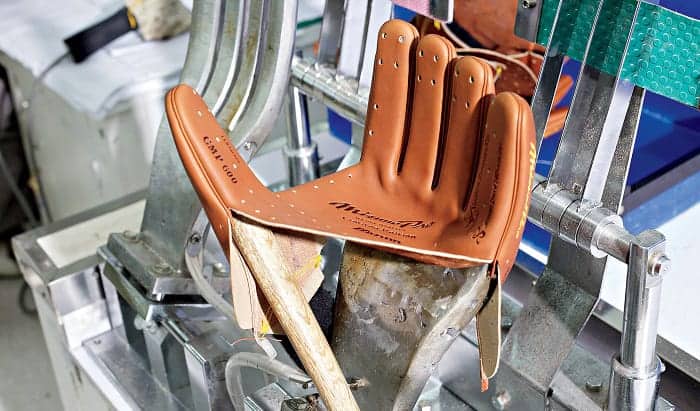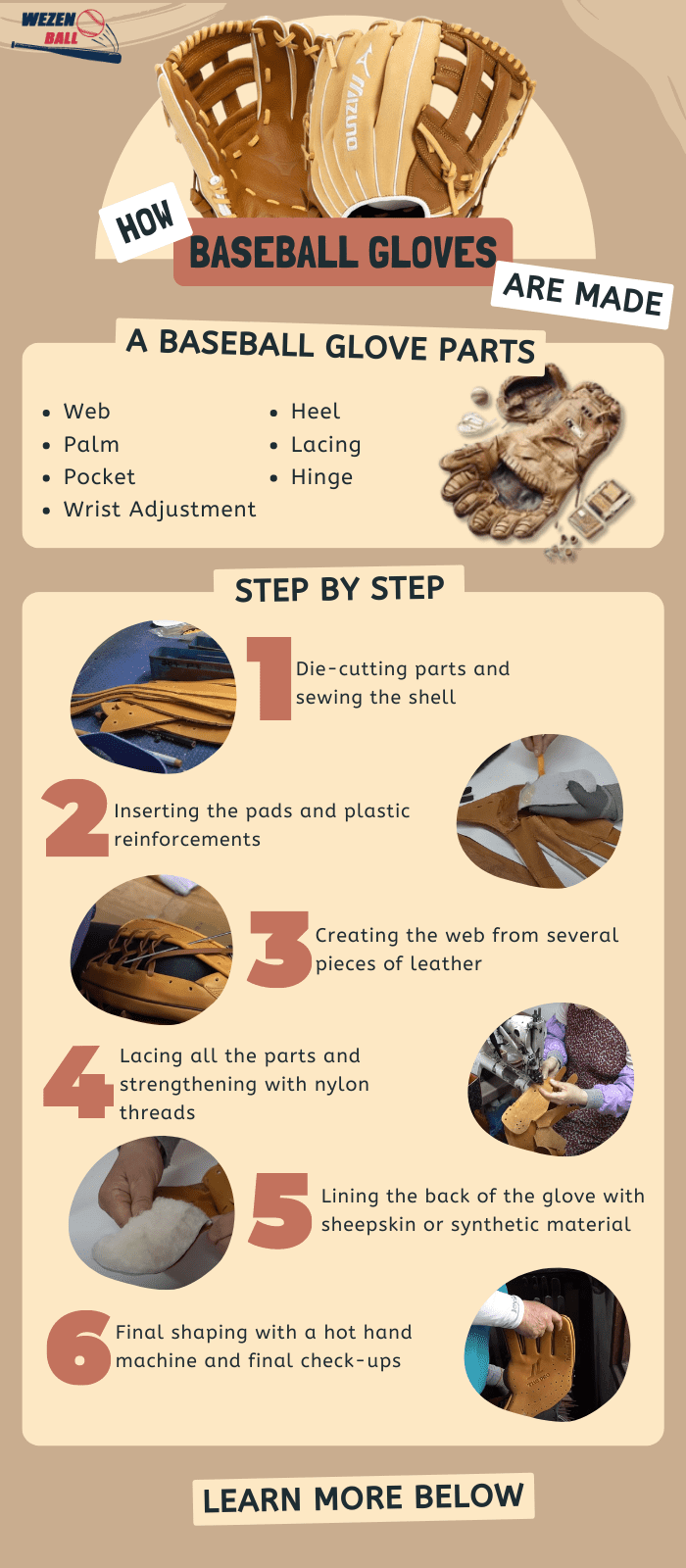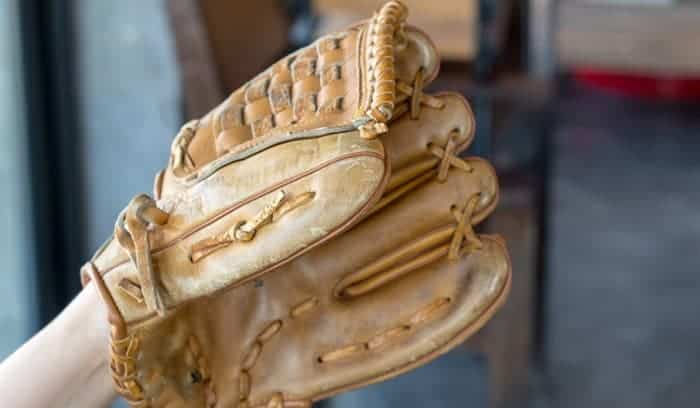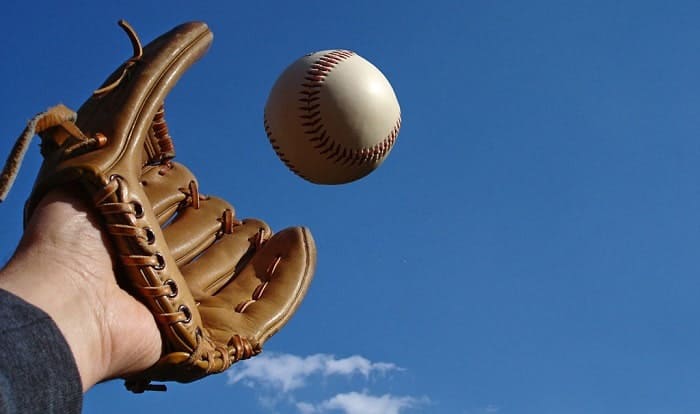Have you ever seen a pair of baseball gloves in person or on TV and wondered about how it was made? Do not worry because you are not alone. Many dedicated fans look into the process of making a baseball glove, so they are aware of all the relevant technical know-how. It will spice up your sports talk too! Understanding this, we have put together an in-depth article on the A to Z production procedure, which in short, includes:
- Die-cutting parts and sewing the shell
- Inserting the pads and plastic reinforcements
- Creating the web from several pieces of leather
- Lacing all the parts and strengthening with nylon threads
- Lining the back of the glove with sheepskin or synthetic material
- Final shaping with a hot hand machine and final check-ups
Needless to say, there is more to know about each step. So, read on to know the details to know how baseball gloves are made.
First, to set the stage for understanding how they are made, we will explore the materials and parts.
Contents
- Baseball Glove Materials
- Baseball Glove Parts
- How Baseball Gloves are Made – Manufacturing Process
- Step 1: Die-cutting parts and sewing the shell
- Step 2: Inserting the pads and plastic reinforcements
- Step 3: Creating the web from several pieces of leather
- Step 4: Lacing all the parts and strengthening with nylon threads
- Step 5: Lining the back of the glove with sheepskin or synthetic material
- Step 6: Final shaping with a hot hand machine and final check-ups
- Additional Steps
- Quality Control
- Baseball Glove Patterns
- Conclusion
Baseball Glove Materials
The raw materials for baseball gloves can be counted on the fingers of one hand. There is plastic, nylon, and leather. The manufacturer used plastic and nylon to reinforce the thumb and fingers, while the remaining was leather. Cowhides are the most common, but some gloves can also be from kangaroo hide, which is softer and easier to break-in.
The cowhides are cured to eliminate bacteria and processed in a tannery, where tanning, a chemical reaction, happens to filter out the low-quality leather. Fine leather converges an ideal blend of durability and flexibility. Quality leather is what most, if not all, baseball companies compete upon.
Although other synthetic materials have been frayed to replace the leather, none are as stretchy and resilient, providing the same feel. Hence, so far, no materials can take over leather’s reign. However, there are certain youth gloves and recreational gloves made of synthetic leather, which is extra lightweight.
A few other minor materials are used, depending on the manufacturer, are glue, sheepskin, and synthetic lining.
Baseball Glove Parts
There are seven main parts of a baseball glove: web, palm, pocket, wrist adjustment, heel, lacing, and hinge.
- Web: This part of the glove connects the thumb and fingers. It is responsible for the control of the ball upon impact. In detail, it includes woven leather that closes up the wearer’s hand for catching motions. The web is particularly useful for fly balls, line drives, and pop-ups. There are many different types of web, varying by players’ position. For example, fielders feature basket, trapeze, modified trap, H-web, I-web, cross, and two-piece webbing. First base gloves are often equipped with a single post, modified H-web, and dual bar webbing, while half-moon and one-piece webbing can be found on catchers’ gloves.
- Palm: This is the center of the glove where the ball comes into direct contact. It features a padding layer to cushion the wearer’s hand from intense impact. By the same token, it reduces the created pressure exerted on the wearer during catching motions.
- Pocket: This is the part of the glove created by the palm. It is an indention that is essentially a funnel-like structure for the ball to fall into when it is caught. Certain gloves will have deeper pockets than others.
- Wrist Adjustment: This refers to any hook-and-loop fasteners, D-rings, and buckle systems that allow wearers to tighten the gloves around their wrist. It is not a standard feature but is relatively common in modern baseball gloves. The wrist adjustment is especially common for gloves in youth baseball, slow, or fast-pitch softball.
- Heel: This refers to the bottom end of the glove’s palm, or the hen of the gloves. It is near the joint between your hands and arms. It is in charge of protecting a wearer’s wrist and hand as a whole. In addition, the heel can determine the break of a pair of gloves.
- Lacing: This part gives shape to the glove. Usually, it is also made of leather because it can break-in along with the other parts.
- Hinge: This part is what permits the gloves to open and close with ease.
Fingers can also be considered a part of a baseball glove. However, not all gloves have fingers. First baseman gloves, for instance, do not have fingers, sporting a conjoined structure that is mitt-like instead.
How Baseball Gloves are Made – Manufacturing Process
Now, we can delve into the detailed manufacturing process.
Step 1: Die-cutting parts and sewing the shell
First, the leather is cut automatically by a machine, called dies or clickers, into four components: shell, lining, lace, and pad. Usually, this is done based on a pre-made baseball glove template.
The parts are hole-punches for later lacing. While inside-out, the shell is sewn together, then inverted to insert the lining. During this, the leather is steamed or wet to prevent cracking. Otherwise, a hand-shaped hot iron and rod can be used to turn the gloves right side out.
The sewn shell is then formed into shape by a heat-inducing machine called the hot hand. At this step, the glove is shaped with a mallet, while laid out and stretched across the machine. The same machine also assures that there are openings for the fingers of the gloves later on.
At this point, certain branded baseball gloves will undergo a sub-step of hot-stamping the company’s logo onto the dies. Other brands, like Wilson, will also stamp on the model information of the pair of gloves.
Step 2: Inserting the pads and plastic reinforcements
Second, the heel of the glove is formed with two inserted pads. These are two layers of leather stitched together. They give the pair of gloves its much-needed flex. Certain gloves that require more padding, like catchers’ mitts, will have at least five layers of leather for the pads. Simultaneously, plastic reinforcements are put into place at the thumb and small finger. They prop the glove and act as a shield for the wearer’s fingers. Certain branded baseball gloves will also use glue at insertions to ensure durability.
Step 3: Creating the web from several pieces of leather
Third, the web is made by itself from several pieces of leather. The exact number depends on the type of webbing the glove features. Usually, it is anywhere from two pieces.
Step 4: Lacing all the parts and strengthening with nylon threads
Forth, all the parts are laced together at the edges of the glove with a single long piece of rawhide. Prior to this step, leather will be cut into thin strips. Starting from the thumb or little finger, the lacing holds the glove as a whole. At the web, lacing is typically stitched with nylon thread for added strength.
Step 5: Lining the back of the glove with sheepskin or synthetic material
Fifth, the back of the glove is lined with sheepskin or a synthetic material.
Step 6: Final shaping with a hot hand machine and final check-ups
Finally, the glove is put onto the hot hand machine again for final shaping. The machine will also check that the finger stalls are still open.
Note: The catchers’ mitts and first base gloves are not sewn by a machine but by hand, with the palm and back sewn first.
Additional Steps
Additional steps can include machine-beating and conditioning the glove with oil. The latter softens the glove and removes any wrinkles. Same same but different, the former hydrates the lather and keeps it from cracking. Famous baseball brand Nokona, for example, applies a thin coat of petroleum mixed with lanolin. You can watch Nokona’s production here as well.
Quality Control
Quality control is a simultaneous process from start to finish. When hides are compiled at the plant, they are tested for color and strength. Only qualified leather can enter the manufacturing stage. At each step along the way, each craftsman conducts his or her own quality control initiatives. As a result, any identified defects will be removed from the chain immediately.
Baseball Glove Patterns
Although there are more designs to choose from today, baseball gloves have not changed dramatically. The classic patterns are still there, just with a few touches here and there. The biggest change is in differentiation between gloves by position. For example, catchers’ mitts are now made with more eye-catching, fluorescent colors to increase visibility for pitchers. Here are a few baseball glove patterns for your reference.
Conclusion
With that, you have reached the end of this article on how baseball gloves are made. Hopefully, you have learned a lot of valuable information.
To recap, the steps to making a baseball glove are:
- Die-cutting parts and sewing the shell
- Inserting the pads and plastic reinforcements
- Creating the web from several pieces of leather
- Lacing all the parts and strengthening with nylon threads
- Lining the back of the glove with sheepskin or synthetic material
- Final shaping with a hot hand machine and final check-ups
Did you enjoy it? Let us know in the comments! Also, if you have any follow-up questions or thoughts, feel free to leave a comment. Do not be afraid to share this article with others as well!

Five years as a baseball player, my training approaches with this game give me the motivation to inspire and support young players more. Like all sports, we should start with the desire to have fun and maintain our resilience to strive better at any competition. But, of course, some of us want to have some fun and train for better health. It does not matter what your initial purpose is; I believe that most people ever holding on to the baseball bat will fall in love with the games as I do.

















